Twelve years on from the beginning of Syria’s war
Millions are still displaced and hundreds of thousands have died in 12 years of fighting, but al-Assad remains in power.
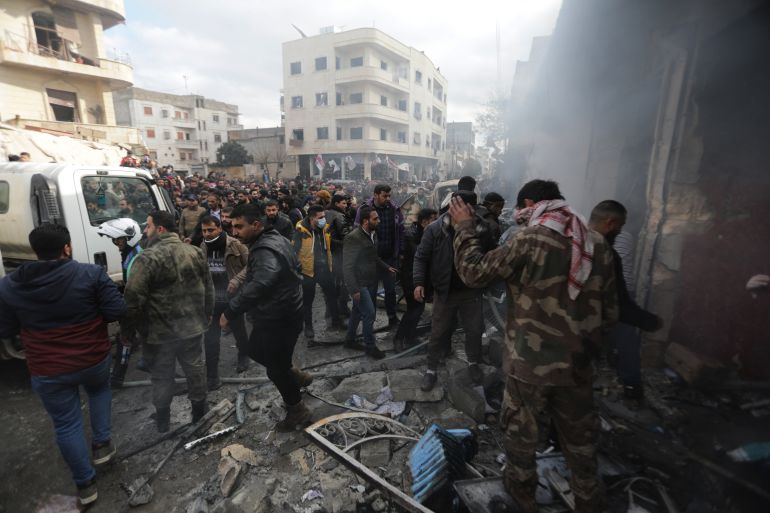
Twelve years ago, protesters dared to take to the streets of Syria to protest against the country’s government and its president, Bashar al-Assad.
The protests quickly took on a revolutionary nature, demanding the “fall of the regime”, but, after a violent response from the government, the uprising transformed into a war, dragging in several outside powers, displacing millions and killing hundreds of thousands.
Keep reading
list of 3 itemsThree wounded in Israeli air attacks on central, west Syria
After earthquakes, Syrians utilise new rules to cross from Turkey
Syria’s economy has deteriorated, with 90 percent of the population now living below the poverty line, according to the World Food Programme.
The United Nations estimated last year that more than 306,000 civilians have been killed – about 1.5 percent of the population – since March 2011 in the country.
The Syrian Observatory for Human Rights, a United Kingdom-based war monitor, estimates the total death toll to be about 610,000.
Even before the earthquakes that devastated northwestern Syria in February, the UN had said that 14.6 million Syrians were in need of humanitarian assistance, with 6.9 million people internally displaced and more than 5.4 million Syrian refugees living in neighbouring countries. Hundreds of thousands also sought asylum in Germany and other parts of the European Union, as well as further afield.
The conflict in the country has largely frozen, although fighting continues intermittently, particularly in the northwest.
Here is a breakdown of how the war unfolded, how territorial control has changed, and who the players are now.
How it started
On March 15, 2011, major unrest erupted across the streets of Deraa, Damascus and Aleppo, with protesters demanding democratic reforms and the release of political prisoners.
Protests were triggered by the arrest and torture of a group of teenage boys a few days earlier in the city of Deraa over graffiti denouncing al-Assad.
A violent crackdown and repression by the government followed. In July 2011, defectors from the military announced the formation of the Free Syrian Army, a rebel group aiming to overthrow the government, turning the revolt into a civil war.
Protests continued into 2012, and by 2013 various rebel groups emerged across the country. Later that year, ISIL (ISIS) emerged in northern and eastern Syria after overrunning large portions of Iraq.
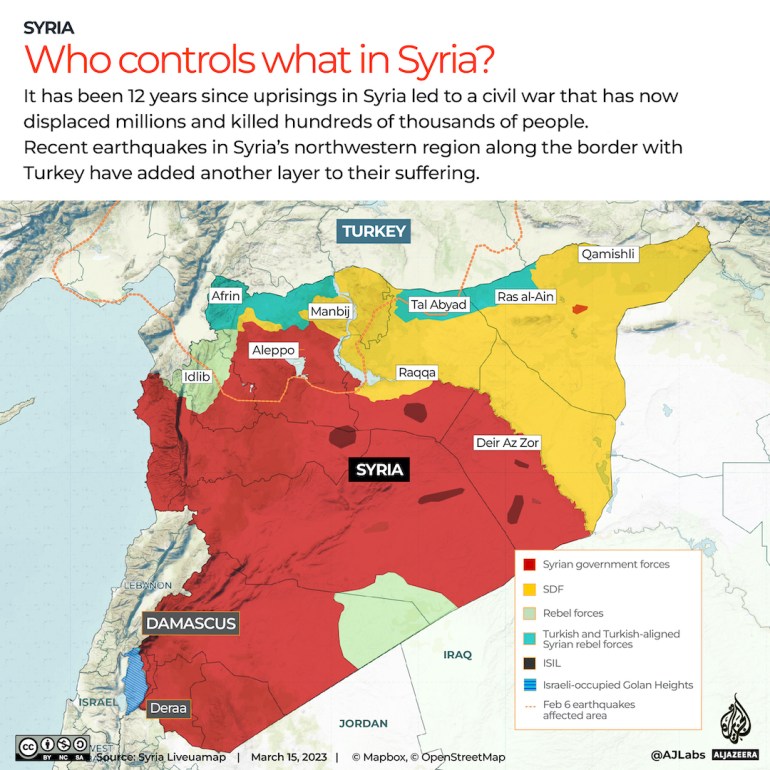
Groups involved
A variety of actors are locked in a power struggle in Syria.
The Syrian government
Bashar al-Assad inherited his rule of Syria in 2000, taking over from his father Hafez al-Assad, who had been in power since 1971.
He has ruled the country with an iron fist and has a history of crackdowns on dissidents, using chemical weapons against his people and imprisoning and torturing thousands.
Free Syrian Army (FSA)/Syrian National Army
The FSA is a loose conglomeration of armed brigades formed in 2011 by defectors from the Syrian army and civilians backed by Turkey and several Gulf countries.
Since the Battle of Aleppo in December 2016, the FSA has remained in control of limited areas of Idlib in northwestern Syria.
Hay’at Tahrir al-Sham (HTS)
HTS was formerly Jabhat Fatah al-Sham and Jabhat al-Nusra.
Jabhat al-Nusra formed in Syria in 2011 as an al-Qaeda affiliate within the opposition to the al-Assad government.
By January 2017, Jabhat Fatah al-Sham rebranded when it merged with several other groups to unite under the banner of Hay’at Tahrir-al Sham.
Currently, HTS maintains that it is “an independent entity that follows no organisation or party”.
Hezbollah
Hezbollah is a Shia armed group and a political force based in Lebanon and backed by Iran. It moved into Syria to support al-Assad’s forces and currently controls no territory in Syria.
The Syrian Democratic Forces (SDF)
This alliance of Kurdish and Arab militias was founded in 2015.
Its makeup largely consists of YPG fighters and smaller groups of Arab, Turkmen and Armenian fighters.
Turkey considers the YPG, which forms the bulk of the SDF forces, an extension of the PKK, which has waged an armed campaign for independence against the Turkish government that has killed more than 40,000 people since 1984.
The main cities under SDF control are Raqqa, Qamishli and Hasakkeh.
ISIL (ISIS)
Predominantly known for the brutality of its foreign fighters, organised government systems, and strong social media presence, ISIL rose to power in the vacuum in Syria after 2012 as civil unrest grew. By 2014, it had captured significant land by force and declared the creation of a “caliphate”.
ISIL’s “caliphate” was destroyed in March 2019 but its re-emergence looms in the region. In 2014, at the peak of its power, it controlled roughly one-third of Iraq and Syria.
Russia
Russia has strongly backed the Syrian government, particularly following a request from al-Assad to intervene militarily in 2015, with opposition forces getting closer to Damascus.
Russian forces stopped the opposition’s advance, but at a heavy cost to civilians, with air attacks, in particular, killing civilians, and reports of hospitals hit.
Moscow is now deeply entrenched in Syria, with military bases under its control, and a government that owes its survival to Russia.
Turkey
Despite formerly close ties between Turkish President Recep Tayyip Erdogan and al-Assad, Turkey quickly swung behind the Syrian opposition in 2011 and became a base for opposition figures.
However, its main military interventions in Syria have been aimed at removing perceived threats to its own internal security.
The first operation, in 2016, mainly targeted ISIL (ISIS), but since then the focus has been on the SDF/YPG. The operations have resulted in Turkey controlling large parts of northwestern Syria along the border, and Ankara continues to threaten another operation to create a “safe zone” along the Turkey-Syria border.
United States
The US initially supported the Syrian opposition, with the aim of overthrowing al-Assad, but did not directly attack the Syrian government until a 2017 missile raid following a reported government chemical weapons attack on civilians.
However, its main focus in Syria has been fighting ISIL (ISIS), and, along with a coalition of allied countries, began to attack ISIL, as well as al-Qaeda affiliate forces, in Syria in 2014.
US forces continue to patrol northeastern Syria alongside the SDF, which it backs. Forces also operate out of Al-Tanf base, in southern Syria, where it has trained opposition fighters.
Iran
Iran has been a long-time ally of al-Assad, and swung behind him as soon as the protests began. Since then, the Iranian military presence has grown in Syria, along with that of Iranian-trained fighters from countries such as Lebanon, Iraq and Afghanistan. These forces have been instrumental in supporting the Syrian government, and have also been accused of human rights abuses.
The US also accuses Iran of backing militia groups that have conducted attacks on US forces in Iran.
The damage of war
Aleppo
Aleppo was an industrial and economic hub in northwest Syria with nearly three million inhabitants at its peak.
In December 2016, the Syrian army scored its biggest victory against the rebels when it recaptured the strategic city. The city had been divided and under rebel control since the beginning of the unrest in 2012.
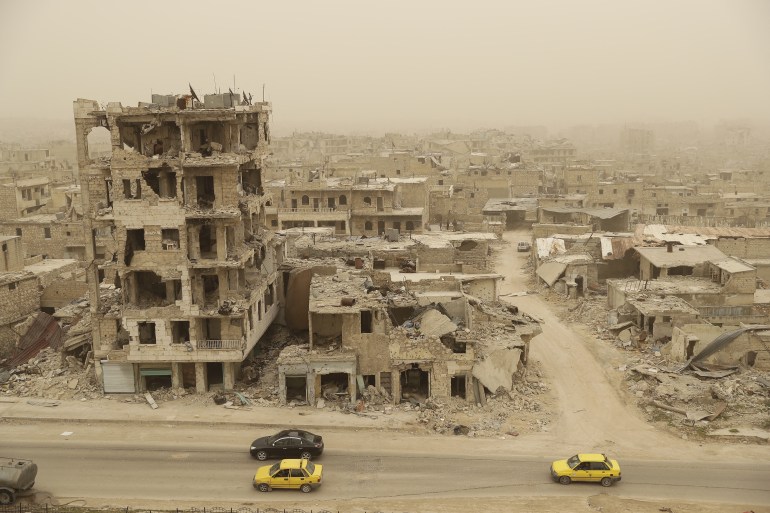
Eastern Ghouta
Eastern Ghouta lies 10km (six miles) east of the capital, Damascus.
In 2018, after a fierce seven-week offensive that left much of the city in ruins, the Syrian army regained control of areas that had been held by opposition fighters since 2012.

Raqqa
Raqqa, situated on the Euphrates River in Syria’s north, was the first governorate capital to fall under opposition control after the start of the Syrian uprising in 2011. In 2014, the city was captured by ISIL (ISIS), who declared it their capital.
Raqqa and many villages and towns in the province were devastated by US-led coalition air raids during the anti-ISIL operation between 2016 and 2017. According to some estimates, between 70 and 80 percent of the city was destroyed and its infrastructure was almost completely wiped out.
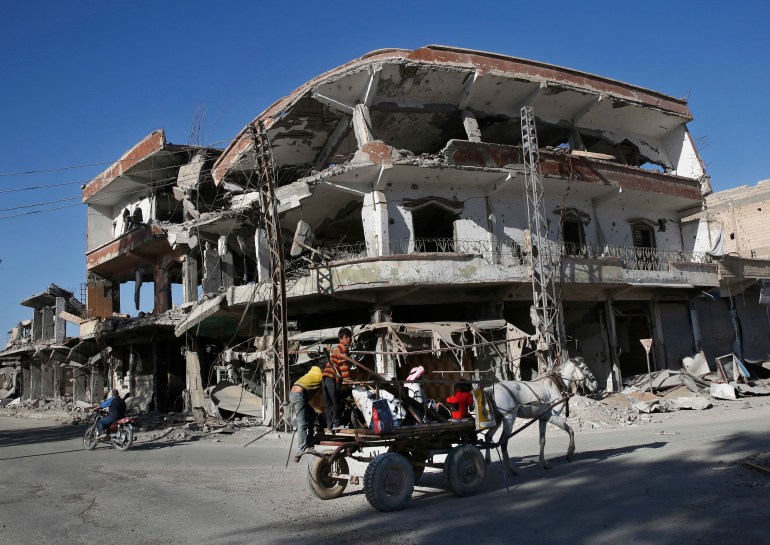
Palmyra
A UNESCO World Heritage site in central Syria, Palmyra was captured twice by ISIL – first in May 2015 and then again in December the following year.
The group destroyed several ancient wonders including the Temple of Bel, the Temple of Baal Shamin, the Arch of Triumph, and columns in the Valley of the Tombs.
In March 2017, the Syrian army, backed by allied forces and Russian warplanes, recaptured the city.

Deir Az Zor
In 2014, ISIL captured Deir Az Zor, an oil-rich governorate located in the east of the country bordering Iraq. The main city was taken by Syrian government forces with help from the SDF in November 2017. It was ISIL’s last urban stronghold in the war-torn country.
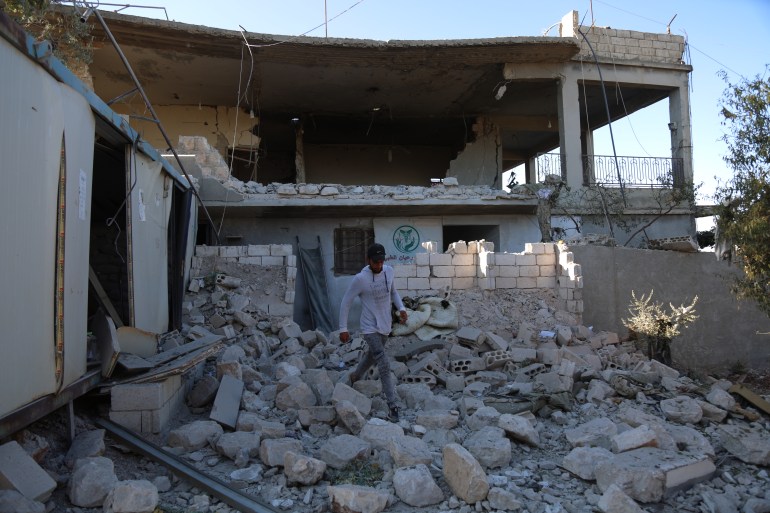
Idlib
The governorate of Idlib on Syria’s northwestern border with Turkey is currently home to more than three million people, the majority of whom are internally displaced. Syrian opposition forces have controlled much of the area since the beginning of the civil unrest, but the government has tightened the noose on it.
Devastating earthquakes
Compounding the suffering caused by the war, deadly earthquakes, with their epicentre just across the border in southeastern Turkey, destroyed vast swaths of northwestern Syria.
Civil defence workers used the skills they had learned pulling people out of the rubble of buildings hit by air strikes to extract survivors in the aftermath of the earthquakes.
So far, more than 7,200 people are reported to have died in both government and opposition-controlled areas of Syria, although that number is expected to rise, especially in opposition-controlled areas, which were some of the worst affected.
Al-Assad’s rehabilitation?
Having been frozen out by much of the international community and by most Arab countries after brutally attacking the Syrian opposition in 2011, al-Assad is slowly being rehabilitated by some Arab countries.
The United Arab Emirates reopened its embassy in Damascus in 2018, before al-Assad was welcomed in Abu Dhabi in March last year, his first official visit to an Arab country since the outbreak of the war.
Many Arab countries now seem to have accepted that al-Assad will stay in power, and have stepped up efforts to bring him back into the fold after February’s earthquakes.
Visits to Syria by politicians from countries such as Egypt, Iraq, Libya and Oman have followed, and there is even talk of Syria being readmitted into the Arab League.
This is an updated version of an article first published on March 15, 2021.